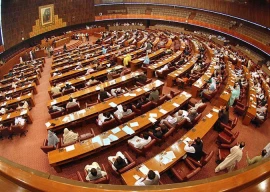
The prime minister’s youth loan scheme is a billion dollar gamble. Every Pakistani will agree on the urgency of enabling the youth and the poorer segments to get good opportunities of employment and economic empowerment. But few experts will concur that the proposed loan scheme will achieve the desired objective. This programme has all the ingredients of yet another ‘yellow cab’ scheme and is likely to put a hundred billion rupees of deposits and taxes at risk.
The global track record of government-sponsored lending programmes, especially in countries like ours with weak institutional arrangements and endemic corruption, is very poor. One problem with such programmes is the trade-off between commercial and social goals — this mostly results in high losses and the non-sustainability of these programmes. Most programmes suffer from high levels of corruption and channelling of funds to political cronies, as we experienced under the governments of the PPP and the PML-N, during the 1990s.
This proposed scheme suffers from several flaws, the most serious being that it is being run by the prime minister’s daughter. Even if she had the experience and credibility of Dr Muhammad Yunus of the Grameen Bank, or was a knowledgeable banker holding executive management positions in global banks, it would have been a terrible idea to have her head this programme. She is certainly smart, but has been appointed to the position, not on merit, but on account of being the party head’s daughter. Her appointment is fraught with a grave danger of turning the programme into a political gravy train. A good model would have been to keep politicians miles away from the programme and to appoint a respected, retired SBP governor to head its board that should have comprised heads of private commercial and microfinance banks.
For any small business, one key to success is a credible business plan and the owner having a good understanding of the business, with preferably some hands-on experience. The scheme’s assumption that the lucky ones selected through ballots will have entrepreneurial talent and can successfully run a business is not based on serious assessment. The selection of borrowers should be left to the banks, rather than through balloting, which is professionally unsound — it may work for distributing laptops, but won’t work for loans which have to be paid back. The success rate of Small and Medium Enterprises Development Authority (SMEDA)-facilitated businesses is low. SMEDA’s feasibility studies are worth less than the paper on which they are printed. Its track record is as good as any other government department — any gold it touches turns into manure.
Providing first-time borrowers with loans up to 90 per cent of the project cost is risky. A critical success factor of a well-performing small loans programme is the gradual increase in debt. A prudent policy would be to start at a debt-to-equity ratio of 50:50 (at most) for the first loan and gradually increase the loan once the entrepreneur shows an ability to run a successful small business.
The absence of private bank participation in the programme clearly indicates that it is an unsound ‘non-bankable’ programme. Government-owned banks are very susceptible to political influence, as we have experienced in the last 20 years, and the track record of the banks participating in this scheme is unimpressive.
The programme indicates that only 50 per cent of loan losses, with a maximum 10 per cent of the loan amount, will be provided by the budget. Anyone knowledgeable about such programmes knows that the losses of the participating banks will have to come out of the budget. Surely, the government is not expecting the depositors of these banks to pick up the losses. The stated loss-sharing is nothing but fiction. The programme will involve significant subsidies and contingent fiscal liabilities. Unless governance arrangements and specific conditions are fundamentally changed, the scheme has the potential of hitting the budget hard at a time when the fiscal crisis is acute. Some 100,000 young people may become PML-N supporters and a few businesses may be started, but the proposed programme as at present designed, is akin to playing poker with deposits and scarce public money.
Published in The Express Tribune, December 18th, 2013.
Like Opinion & Editorial on Facebook, follow @ETOpEd on Twitter to receive all updates on all our daily pieces.
COMMENTS (5)
Comments are moderated and generally will be posted if they are on-topic and not abusive.
For more information, please see our Comments FAQ

































































If you want to get loan then contact your MNA / MPA than wasting time formalities.
Is this for real? Applicants will be selected through ballot? What is wrong with pmln!
There has to be a difference in approach between sanction of bank loans and a raffle draw through ballot. Why the two participating banks have agreed to the abllot scheme. Both the banks claim to have a Project Finance Dept. Truly said, bankers make money out of nothing.
It is not a question of whether this will turn into a political gravy train, it is one.
Bank Loans schemes like this is one of the tried and testing methods to distribute the entire billion dollar curpus between the officials and favorite "entreprenuers".